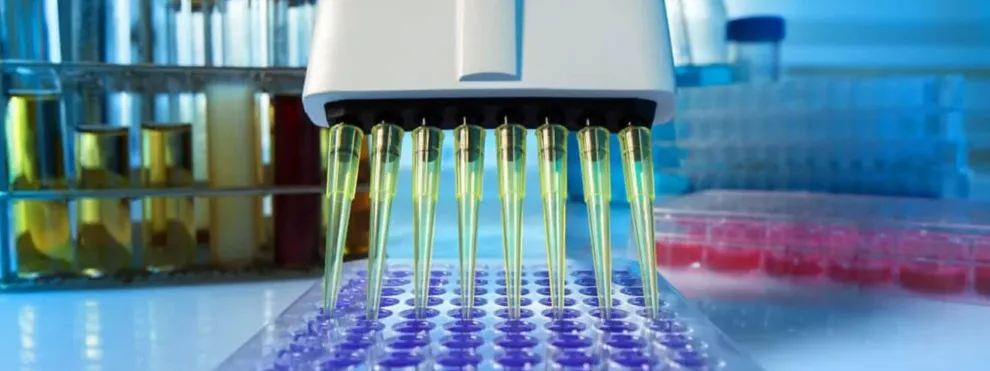 A biomarker is a defined characteristic that is measured as an indicator of normal biological processes, pathogenic processes, or biological responses to an exposure or intervention, including therapeutic interventions(1). With the development of innovative and personalized therapies, biomarker tracking is increasingly important to support the clinical development of biologics and small molecules. It is crucial in every stage of drug development as it contributes to understanding the mode of action, controlling drug candidate safety, and predicting and/or correlating with clinical response. It plays a significant role in decision-making, early project termination, clinical program prioritization, or in accelerating the availability of new therapeutics on the market.
A biomarker is a defined characteristic that is measured as an indicator of normal biological processes, pathogenic processes, or biological responses to an exposure or intervention, including therapeutic interventions(1). With the development of innovative and personalized therapies, biomarker tracking is increasingly important to support the clinical development of biologics and small molecules. It is crucial in every stage of drug development as it contributes to understanding the mode of action, controlling drug candidate safety, and predicting and/or correlating with clinical response. It plays a significant role in decision-making, early project termination, clinical program prioritization, or in accelerating the availability of new therapeutics on the market.
Among the different types of biomarkers, soluble biomarkers can be detected and measured in biological fluids, such as blood, cerebrospinal fluid, synovial fluid, urine(1)…. They offer a convenient way of assessing (patho)physiological responses such as immune activation and inflammatory reactions. They present substantial advantages such as the non-invasive collection and the ability to perform sequential analysis during follow-up. At KCAS, our clients typically measure circulating biomarkers for pharmacodynamic, target-engagement or exploratory purposes, that may convert into prognostic or companion-diagnostic markers.
Soluble Biomarker Analysis at KCAS
For more than a decade now, Active Biomarkers, a KCAS company, has stood as a leader in the analysis of soluble biomarkers, with a historic core activity of immune monitoring in the immuno-oncology and infectious diseases fields. Leveraging on our growing experience in immune system assessment and relying on a wide diversity of technological platforms, our teams have since then supported studies in other immune-related diseases such as autoimmune and inflammatory diseases.
Our expertise is not limited to immunology. Indeed, a few years ago, riding the wave of ultrasensitive technologies, we started building a portfolio of methods for monitoring neurological biomarkers (e.g. beta-amyloid, tau, Nfl, GFAP…) in biological fluids, related to neurotoxicity, neuronal damage, inflammatory processes, and blood-brain barrier integrity. By monitoring these biomarkers, we can allow for better disease activity monitoring or a better understanding of drug response. For instance, NfL measurement might be considered as an objective estimate of disease activity for the individual living with Amyotrophic Lateral Sclerosis(2) or even be relevant in the context of repetitive sports-related concussions and patients with subacute and chronic traumatic brain injury(3).
Our deep knowledge in the field of biomarkers enabled us to help our clients better understand the impact of their cutting-edge therapies and document the mechanisms of action of their molecules.
Our expertise helps you overcome the challenges of establishing the right biomarker context-of-use (CoU)
Biomarkers analysis can offer game-changing information during clinical development, providing that their context-of-use (CoU) is clearly defined. This is important to allow for the selection of the most appropriate method as well as the most relevant parameters for evaluating its performance. It is essential to have a carefully planned strategy to accurately determine which soluble biomarkers should be measured and to provide a rationale for this decision. The focus should be on identifying which biomarkers are relevant for tracking and characterizing the outcome of the molecule of interest. This comes with a clear understanding of the biology of the therapeutic candidate, its target(s), and anticipated effects on the selected biomarkers (activating or inhibitory effect, concentration range in the target population…). Establishing the context-of-use (CoU) will provide guidance for decisions on which kit, technology, and validation method to choose from the available resources.
This is where our expertise is valuable. Our extensive experience of over 10 years in the field enables us to promptly address scientific inquiries and guide our sponsors towards fine-tuning their strategy by asking the right questions and building the most appropriate design to implement context-of-use principles(4). Moreover, at Active Biomarkers, we rely on one of the most comprehensive technology parks in Europe. Taken together, these strengths enable us to successfully address the unique challenges associated with each sample we work with. We provide guidance to ensure that the right assays with the right level of validation are set up and that the generated data can be efficiently & reliably exploited by the study sponsors. This is important for achieving success and building trust with clients.
As part of KCAS family of companies, Active Biomarkers is well-positioned to meet the demands of globally scaled projects.
Active Biomarkers, being part of the KCAS family of companies, can now offer global services to its clients. Harmonized technology platform, cross-validated methods as well as overarching quality system and SOPs across sites in North America and Europe allow for swift handling of international projects. This means that we can efficiently handle and process samples from diverse sources and test them locally. It also ensures that generated data are comparable across sites which is highly important for globally scaled projects. In addition to the harmonized processes, clients can now benefit from an enhanced workforce, increased services portfolio, and unique specializations across locations; they can be sure they are receiving solutions specifically tailored to their project needs and strictly respecting local regulations.
Key takeaways
Active Biomarkers is a key player in the implementation of bioanalytical methods for drug-responsive biomarkers, relying on its profound expertise, comprehensive technology and, its global expansion with the KCAS family to provide consistent and reliable data. We are committed to staying on the cutting edge of biomarker research and being on the lookout for innovative methods. Reach out today to start your biomarker investigations.
1 FDA-NIH Biomarker Working Group. BEST (Biomarkers, EndpointS, and other Tools) Resource [Internet]. Silver Spring (MD): Food and Drug Administration (US); 2016-. Glossary. 2016 Jan 28 [Updated 2021 Nov 29]. Availablefrom: https://www.ncbi.nlm.nih.gov/books/NBK338448/ Co-published by National Institutes of Health (US), Bethesda (MD).
2 Thompson AG, Gray E, Verber N, Bobeva Y, Lombardi V, Shepheard SR, Yildiz O, Feneberg E, Farrimond L, Dharmadasa T, Gray P, Edmond EC, Scaber J, Gagliardi D, Kirby J, Jenkins TM, Fratta P, McDermott CJ, Manohar SG, Talbot K, Malaspina A, Shaw PJ, Turner MR. Multicentre appraisal of amyotrophic lateral sclerosis biofluid biomarkers shows primacy of blood neurofilament light chain. Brain Commun. 2022 Feb 9;4(1):fcac029. doi: 10.1093/braincomms/fcac029. PMID: 35224491; PMCID: PMC8870425.
3 Shahim P, Politis A, van der Merwe A, Moore B, Chou YY, Pham DL, Butman JA, Diaz-Arrastia R, Gill JM, Brody DL, Zetterberg H, Blennow K, Chan L. Neurofilament light as a biomarker in traumatic brain injury. Neurology. 2020 Aug 11;95(6):e610-e622. doi: 10.1212/WNL.0000000000009983. Epub 2020 Jul 8. Erratum in: Neurology. 2021 Mar 23;96(12):593. PMID: 32641538; PMCID: PMC7455357
4J Cowan K, Golob M, Goodman J, Laurén A, Andersen L, Decker P, Dejager L, Fjording MS, Groenen P, Jasnowski R, Justies N, Kimberg M, Kunz U, Lawrence J, Richter M, Sordé L, Trigt RV, Vermet L, Vitaliti A, Wright M, Timmerman P. Biomarker context-of-use: how organizational design can impact the implementation of the appropriate biomarker assay strategy. Bioanalysis. 2022 Jul;14(13):911-917. doi: 10.4155/bio-2022-0143. Epub 2022 Jul 29. PMID: 35904153.
If you have any questions about these services or any others offered by KCAS, please use the form below. Thank you!

